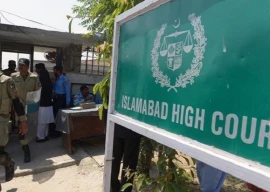
For at least two-and-a-half centuries, Masjid Sehr, an architectural gem of masterful woodwork and stone-cutting, stood surrounded by pine trees on a hillock in a remote village in the Nagri Totial area of Abbottabad.
Then it was destroyed.
The cause was not sectarian hatred, natural disaster or accidental fire. Rather, there were simply too many people in the village who wanted to pray. The beautiful old mosque could not hold them all. In our functional times, the village elders came together in a Jirga and decided unanimously to demolish the historic mosque. A new one is being built on the site.
The mosque did qualify for protection against structural damage under the antiquities law. Nevertheless, the will for expansion won out.
“Our great grandfather Sardar Mehmood Khan, a local landlord, had built the mosque about 250 years ago and it was named Sehr Masjid, which means ‘mosque built on height’,” said Sardar Muhammad Shafique, who claims to be one of the descendants of Sardar Mehmood Khan.
He said that initially the mosque consisted of only one, though spacious, room, but was later expanded, with a main hall measuring 25m by 14m, a veranda 25m by 8m and a courtyard 50m by 14m.
Master wood-carvers were hired to beautifully create the pillars, roof columns, windows, doors and cupboards. Local masons, Shafique said, used chiselled local hard stone for the walls and made Sehr Masjid an archaeological treasure.
The mosque had a capacity of 300 people, but with the village’s growing population – now as high as 5,000 – the masjid committee overlooked the archaeological and aesthetic importance of the mosque and decided to expand the covered area.
“We took everyone on board before the demolition,” said Haji Abdul Rasheed, president of the masjid committee. He claimed that the decision was unanimous and the intention was to rebuild the mosque with a capacity of 1,000 people. Rahseed said it was difficult for villagers to offer juma prayers comfortably due to the mosque’s limited structure.
He added that, according to the new plan, the mosque will be a triple-story building with modern facilities.
Not all the old material will be discarded. Rasheed said the committee would try to reuse the wooden door, windows and cupboards, which were in decent condition. Those parts of the building which had decayed due to age or weather would be thrown away.
Asked if it was against the law to destroy the artifacts of anthropological importance, Rasheed seemed to be completely oblivious to the Antiquities Act 1975.
Shakir Ullah Khan, an assistant professor in the archaeology department at Hazara University, said that although he had not seen the doors and windows of the mosque, the period of construction appeared to be even older than originally thought. He said that the mosque could even have been built between 1707 and 1800, when there was a strong Mughal presence in the area.
Shakir also said that wood-carving was originally a Buddhist art, inherited by Muslims in the region. According to Shakir, the mosque would also have had design elements which have their origins in pre-Muslim culture: scroll patterns, rosettes and inverted lotus flowers on the column base.
The Antiquities Act 1975, Shakir said, dictates that a building or carving of historical importance which is at least 75-year old must be protected and should be preserved for future generations. He said that it was crime to destroy, damage or change the structure of such buildings, but if the woodwork and stone carvings were still intact, the archaeology department at Hazara University would try to preserve them, with the permission of the provincial government.
Published in The Express Tribune, March 28th, 2012.
COMMENTS (4)
Comments are moderated and generally will be posted if they are on-topic and not abusive.
For more information, please see our Comments FAQ

1732243059-0/mac-miller-(2)1732243059-0-165x106.webp)

1672385156-0/Andrew-Tate-(1)1672385156-0-165x106.webp)
1732240377-0/mac-miller-(1)1732240377-0-165x106.webp)





1732240636-0/WhatsApp-Image-2024-11-21-at-19-54-13-(1)1732240636-0-270x192.webp)






very bad.
Horrible!
Fools - they could have constructed another mosque instead of demolition of age old historical prayer house. It is blasphemy.
wow !!!! what a reasoning !!! way to go Jirga ! cheers ! i think rohtas shud be next ! or may be wazir khan mosque ! had it been a 10 year old mosque being demolished to widen a road ! there wud have been protests and riots !!